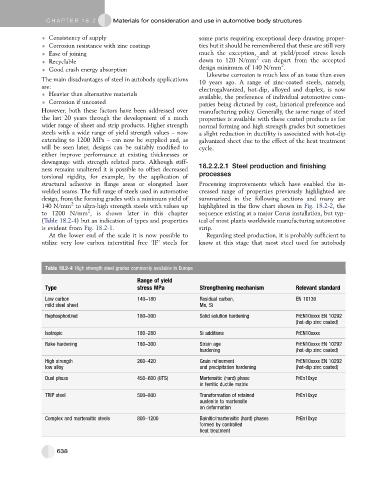Page 630 - Automotive Engineering Powertrain Chassis System and Vehicle Body
P. 630
CHAP TER 1 8. 2 Materials for consideration and use in automotive body structures
Consistency of supply some parts requiring exceptional deep drawing proper-
Corrosion resistance with zinc coatings ties but it should be remembered that these are still very
Ease of joining much the exception, and at yield/proof stress levels
2
Recyclable down to 120 N/mm can depart from the accepted
2
Good crash energy absorption design minimum of 140 N/mm .
Likewise corrosion is much less of an issue than even
The main disadvantages of steel in autobody applications 10 years ago. A range of zinc-coated steels, namely,
are: electrogalvanized, hot-dip, alloyed and duplex, is now
Heavier than alternative materials
available, the preference of individual automotive com-
Corrosion if uncoated panies being dictated by cost, historical preference and
However, both these factors have been addressed over manufacturing policy. Generally, the same range of steel
the last 20 years through the development of a much properties is available with these coated products as for
wider range of sheet and strip products. Higher strength normal forming and high strength grades but sometimes
steels with a wide range of yield strength values – now a slight reduction in ductility is associated with hot-dip
extending to 1200 MPa – can now be supplied and, as galvanized sheet due to the effect of the heat treatment
will be seen later, designs can be suitably modified to cycle.
either improve performance at existing thicknesses or
downgauge with strength related parts. Although stiff-
ness remains unaltered it is possible to offset decreased 18.2.2.2.1 Steel production and finishing
torsionalrigidity, forexample,bythe applicationof processes
structural adhesive in flange areas or elongated laser Processing improvements which have enabled the in-
welded seams. The full range of steels used in automotive creased range of properties previously highlighted are
design, from the forming grades with a minimum yield of summarized in the following sections and many are
2
140 N/mm to ultra-high strength steels with values up highlighted in the flow chart shown in Fig. 18.2-2, the
2
to 1200 N/mm , is shown later in this chapter sequence existing at a major Corus installation, but typ-
(Table 18.2-4) but an indication of types and properties ical of most plants worldwide manufacturing automotive
is evident from Fig. 18.2-1. strip.
At the lower end of the scale it is now possible to Regarding steel production, it is probably sufficient to
utilize very low carbon interstitial free ‘IF’ steels for know at this stage that most steel used for autobody
Table 18.2-4 High strength steel grades commonly available in Europe
Range of yield
Type stress MPa Strengthening mechanism Relevant standard
Low carbon 140–180 Residual carbon, EN 10130
mild steel sheet Mn, Si
Rephosphorized 180–300 Solid solution hardening PrEN10xxxx EN 10292
(hot-dip zinc coated)
Isotropic 180–280 Si additions PrEN10xxxx
Bake hardening 180–300 Strain age PrEN10xxxx EN 10292
hardening (hot-dip zinc coated)
High strength 260–420 Grain refinement PrEN10xxxx EN 10292
low alloy and precipitation hardening (hot-dip zinc coated)
Dual phase 450–600 (UTS) Martensitic (hard) phase PrEn10xyz
in ferritic ductile matrix
TRIP steel 500–800 Transformation of retained PrEn10xyz
austenite to martensite
on deformation
Complex and martensitic steels 800–1200 Bainitic/martensitic (hard) phases PrEn10xyz
formed by controlled
heat treatment
638

